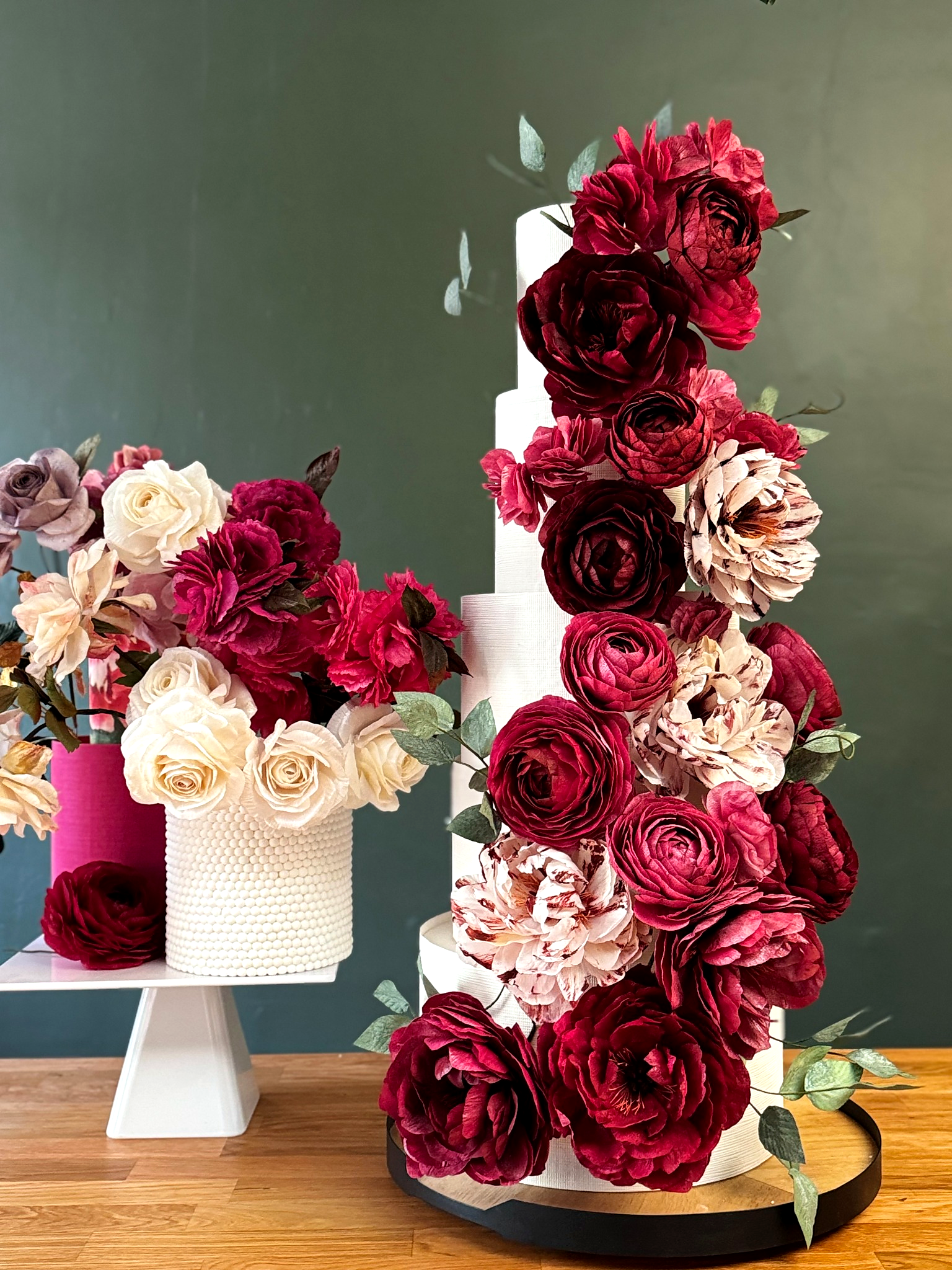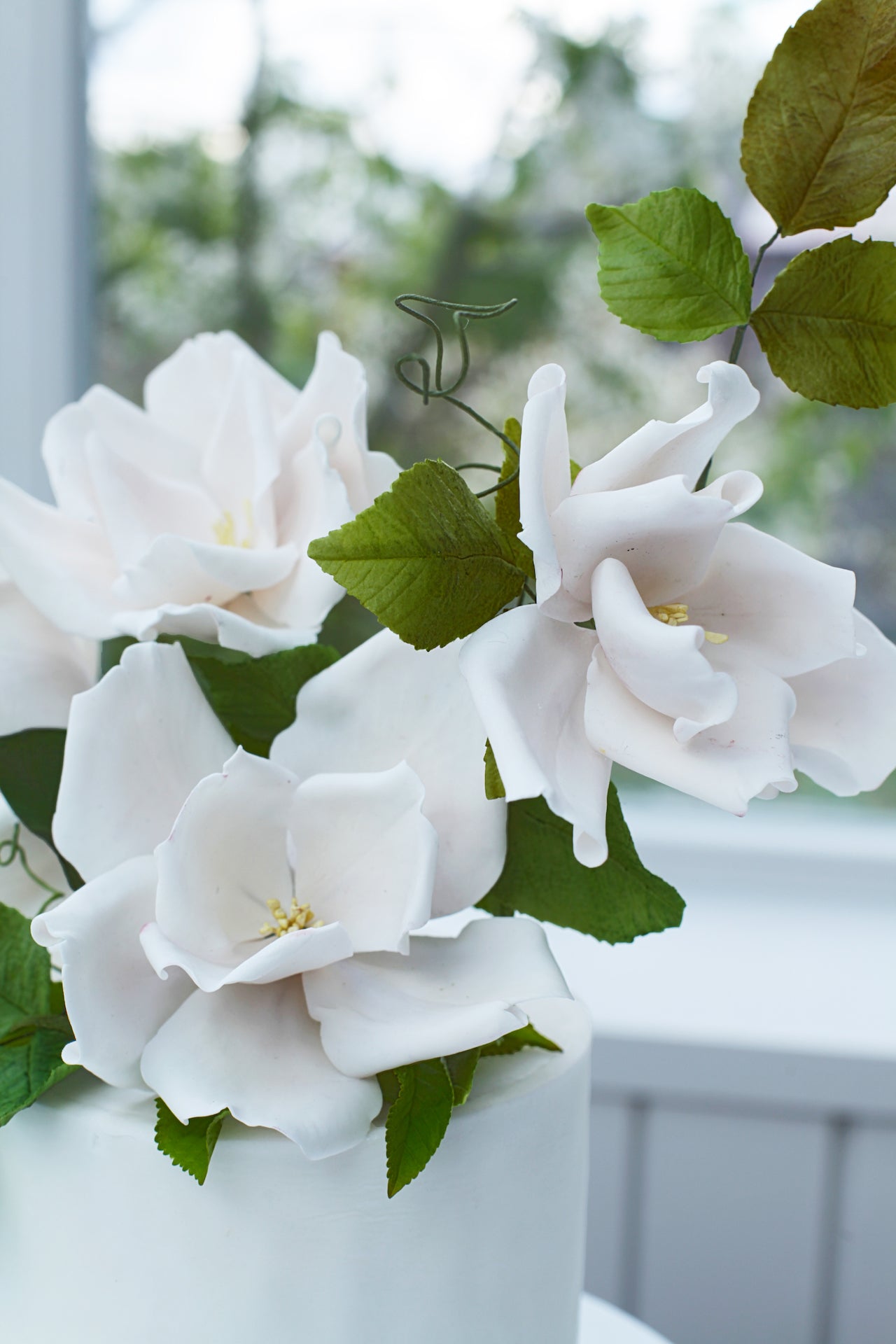My Early Mistake: Perfect Petals, Awkward Bouquets
I spent my first months in wafer‑paper land obsessing over individual flowers—getting the veining right on a ranunculus, perfecting the curl of a peony petal.
When it came time to arrange those beauties on a cake, everything defaulted to the social‑media template: three statement flowers plus one eucalyptus sprig. Pretty, yes; unforgettable, no.
Why Florist Rules Still Matter on Cake
Professional florists rely on a handful of design principles that translate perfectly to edible art:
| Florist Principle | How It Guides Cake Décor |
|---|---|
| Balance | Prevents a cake from looking lopsided; distributes visual “weight.” |
| Scale & Proportion | A four‑tier wedding cake can carry much larger blooms than a single‑tier smash cake. |
| Focal Point | One hero bloom or color zone pulls the eye; everything else supports it. |
| Movement & Line | The direction of petals can lead the viewer’s gaze around the cake. |
| Color Harmony | Triadic, complementary, or—my favorite—monochrome palettes. |
Scale: Think in Tiers, Not Inches
-
A 6‑inch tier thrives with two or three small blossoms (about 1–1.5 inches across).
-
An 8‑inch tier accepts one medium focal bloom plus supporting buds.
-
Ten inches and up? Go big—oversized petals balance the larger canvas.
Balance Without Perfect Symmetry
Instead of plonking identical flowers at 10‑, 2‑ and 6‑o’clock, try placing one large bloom low‑left and countering it with two smaller buds high‑right. Fill negative space with wafer‑paper leaves or ribbons rather than mirror‑image shapes.
Focal Point & Movement
Choose one focal bloom—or one concentrated patch of colour. Angle supporting petals so their tips point toward that hero; the viewer’s eye will follow the implied line, just as it would in a bridal bouquet.
Color: Why Monochrome Wins in Wafer Paper
Real flowers rely on subtle hue shifts; wafer paper begins as a blank canvas. That blankness is a gift:
-
All‑white compositions showcase translucency and layering without distraction.
-
Single‑hue gradients—blush to dusty rose to deep mauve—feel luxurious but controlled.
-
A monochrome palette forgives small shaping flaws because the viewer focuses on silhouette and light.
You Don’t Have to Clone Real Flowers
Perfectionism is tempting, but you don’t need a botanist’s approval. Florists routinely scale silk blooms for shape and drama; wafer‑paper artists can exaggerate curve, ruffle and size to suit the cake’s architecture. Aim for recognisable essence, not botanical carbon copies.
Composition Spotlight: All‑White Wafer‑Paper Cascade analysis (through the florist‑lens we covered)

| Principle | How it shows up in the photo |
|---|---|
| Balance | The cake is centred, but the floral mass leans right and upward, creating an airy asymmetry that counters the solid, cylindrical tiers. |
| Scale & Proportion | Large garden‑rose‑style blooms occupy the middle tier—perfect for that visual “waistline.” Smaller buds and leaves taper toward the top, keeping proportion with decreasing tier diameter. |
| Focal Point | The eye lands on the open central rose, then flows downward through the two rounded peonies. Clear hierarchy without crowding. |
| Movement & Line | Stems arc diagonally from lower left to upper right, guiding the viewer in a gentle S‑curve. The background foliage reinforces that organic direction. |
| Color Harmony | A monochrome all‑white palette on the cake contrasts naturally against the deep green backdrop—no competing hues, which spotlights texture. |
| Negative Space | The top left quadrant is intentionally lighter on blooms, preventing the arrangement from feeling boxy or heavy. |
Overall, it honours every rule we laid out: asymmetric balance, clear focal bloom, scaled sizing, a single colour family, and movement provided by stem angles rather than extra foliage.
.
Florist rules aren’t shackles; they’re scaffolding. Master balance, scale and movement, and you’ll break free of the “three‑roses‑plus‑eucalyptus” rut. Wafer‑paper art can then do what it does best—deliver impossible shapes, sizes and palettes fresh flowers never could.
(Want the deeper petal‑engineering secrets? They debut soon in my book—stay tuned!)


